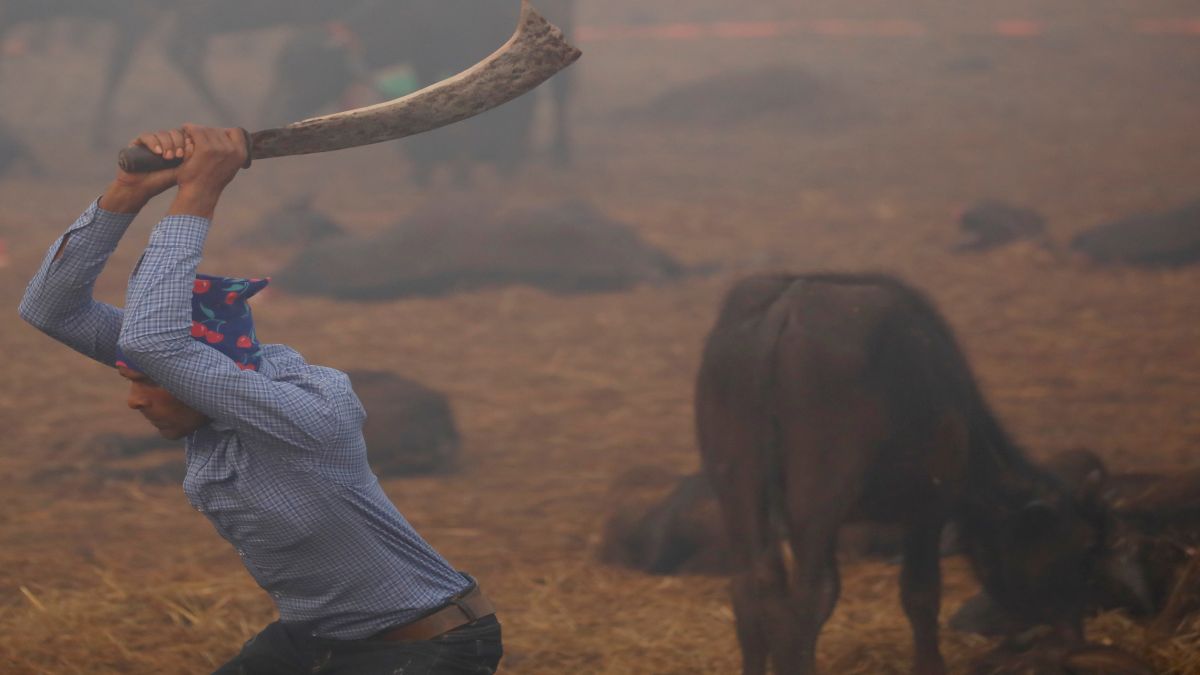This week, starting December 8, thousands of devotees have congregated at Bariyarpur village near the Nepal-India border to mark the Gadhimai festival — an event that is in equal parts revered as well as dubbed controversial.
But why controversial? The Gadhimai festival, celebrated every five years, sees the killing of thousands of animals — from rats and pigeons to goats and water buffalos — in belief that the mass sacrifice will appease the Hindu goddess Gadhimai, who will in return bring them prosperity.
Also known to some as the world’s bloodiest festival, it has drawn condemnation from animal activists from across the world.
But what exactly is the Gadhimai festival and why are thousands and thousands of animals sacrificed during it?
(Please note: Some will find the images in the report to be upsetting)
What is the Gadhimai festival?
The Gadhimai festival is a Hindu festival held every five years at the Gadhimai Temple of Bariyarpur, in Bara District, about 160 kilometres south of the capital Kathmandu. The origins of Gadhimai date back to over 250 years to 1759.
Legend has it that the festival originated when the founder of the Gadhimai Temple, Bhagwan Chowdhary, had a dream that the goddess Gadhimai wanted blood in return for freeing him from prison, protecting him from evil and promising prosperity and power. The goddess asked for a human sacrifice, but Chowdhary successfully offered an animal instead.
Since then, the festival has seen mass animal sacrifice — every five years. Today, participants believe that the animal sacrifice, which includes goat, rat, chicken, pig and a pigeon and buffalo, ends evil and can bring prosperity.
Impact Shorts
More ShortsWhile CNN reports that at least 4,200 buffaloes and thousands of goats and pigeons have already been sacrificed in this year’s festival, Humane Society International (HSI) estimates that 500,000 animals were slaughtered in 2009. This has since gone down to around 250,000 animals in both 2014 and 2019 — including thousands of water buffaloes.
How have activists tried to stop Gadhimai festival?
Activists across the world have condemned the Gadhimai festival , expressing outrage and anger over the deaths of so many animals. Groups have called for the end to the slaughter, with People for Ethical Treatment of Animals (Peta) writing to Nepal Prime Minister KP Sharma Oli, to take decisive action to halt mass slaughter of animals ahead of this year’ Gadhimai Festival.
Kiran Ahuja, manager of Vegan Projects, Peta India said, “Mass animal sacrifice must be stopped, not only for the animals but for our own safety. The intermingling of bodily fluids in such settings creates an ideal environment for zoonotic diseases to emerge.”
Arkaprava Bhar, from HSI, told CNN, “They have butchers who come and slaughter the buffaloes in a row, it’s a massacre.”
He added that the entire area is filled with buffalo heads and blood. “It was barbaric and unhygienic, which could have public health risks. There were many children witnessing the sacrifices, which could be traumatic for them,” he was quoted as saying by South China Morning Post.
In the past, former French actor Brigitte Bardot wrote a letter to the Nepalese government arguing that the killings are “violent, cruel and inhumane”.
Acharya Prashant, a famous spiritual teacher, has also asked devotees to “uphold the sanctity of all life during Gadhimai.” In November, he was quoted as saying, “Devotion should inspire compassion, not cruelty. Slaughtering animals in the name of the divine diminishes the spirit of worship.”
The efforts of activists bore fruit in 2014 when the Supreme Court of India prohibited the transport of live animals across the border to Nepal following a petition from animal welfare activist Gauri Maulekhi. Incidentally, many of the animals, which are sacrificed for the festival, cross borders from India to Nepal. According to Sneha Shrestha, president of the Federation of Animal Welfare of Nepal, 80 per cent of the animals come from India.
A year later, the caretakers of the Gadhimai Temple announced that the festival would be “blood free”. However, they later clarified that while they wouldn’t slaughter animals, they wouldn’t stop devotees from doing so.
Mangal Chaudhary, the temple’s priest, was quoted telling South China Morning Post, “People come with the belief that the sacrifices will help them accomplish their wishes. We don’t encourage devotees to sacrifice animals, but if they bring them, we don’t turn them away.”
Before this year’s festival, India’s former Union minister Maneka Gandhi , among others, also wrote to Bihar’s Chief Minister Nitish Kumar, urging him to stop the illegal transportation of cattle from the state to Nepal for sacrifice. Gandhi in her letter that around Rs 10 million (1 crore) worth of Indian buffaloes alone are smuggled monthly and sold in Nepal’s markets.
What do devotees say?
But despite the many efforts of animal rights activists and even Nepal’s Supreme Court ruling in favour of ending live animal sacrifice at the festival, the practice continues. Upendra Kushwaha, whose family has been part of the festival for years, told CNN, “This is part of our culture, it’s our tradition, they will never be able to stop it.”
And Shristi Bhandari, executive director of Jane Goodall Institute Nepal, understands this sentiment. In the same CNN report, she is quoted as saying, “Animals are sacrificed in various religious rituals in Nepal year-round, so they feel why are they being singled out, why is all this attention, and international attention, on them.”
Bishnu Prasad Dahal, assistant professor of anthropology at Kathmandu’s Patan Multiple Campus, is of the opinion that to stop this practice one may need to change the religious structure in its entirety.
Shyam Prasad Yadav, Gadhimai’s mayor, told The Telegraph: “The issue of animal sacrifice is a matter of people’s faith and belief… Although animal rights activists have raised questions and suggested reducing the practice, it seems unlikely to happen in the near future.”
With inputs from agencies


)

)
)
)
)
)
)
)
)



